Ending Environmental Racism in The Bronx
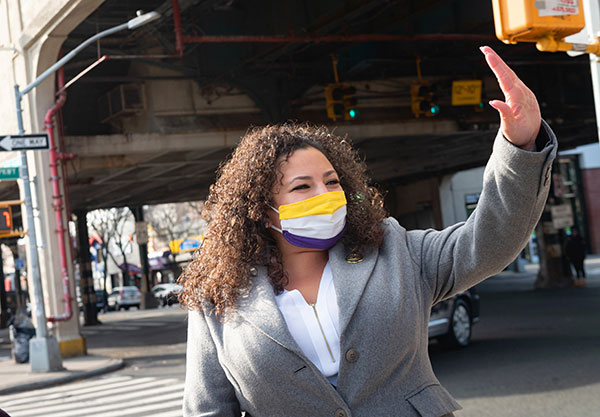
Nathalia Fernández (photo: Fernández campaign)
New York City is the greatest city in the world, but we have let others surpass us in protecting vulnerable populations from the most significant threat facing our planet: climate change.
In the South Bronx, reducing air pollution rates is a matter of life or death. With 15,000 trucks commuting through the area daily, the borough has become an island of pollution, and communities of color are disproportionately suffering.
Last week, I introduced my plan for a greener Bronx to achieve the true environmental justice Bronxites desperately need. With it, we will uplift and empower our communities while making The Bronx the greenest borough in New York City.
It is time to take concrete steps to address environmental racism in our borough. We must invest in renewable energies, upgrade our infrastructure, create good-paying green jobs, and improve both our air and water quality. We cannot meet this need by relying on traditional, incremental programs. We must meet the magnitude of this moment by implementing new policies and funding investments that not only revitalize but transform The Bronx.
South Bronx neighborhoods are tucked between three major highways — the Major Deegan, the Bruckner, and the Cross Bronx expressways — and the asthma rate is eight to twelve times higher than the national average. According to New York City’s community health profiles, Mott Haven and Melrose had three times as many hospitalizations for asthma as the rest of the city, and 1.5 as many as the rest of The Bronx. In Hunts Point and Longwood, the rate of asthma emergency room visits among children ages 5 to 17 is nearly double the citywide rate.
As borough president, I will prioritize reducing the borough’s carbon footprint by advocating for our fair share of funding to implement new greenhouse gas emission limits. For too long, we have been overlooked when it comes to transportation investments, leaving thousands of Bronxites in transit deser ts without access to affordable and reliable public transportation. I will focus on creating sustainable transportation options, like expanding bike-sharing borough-wide and building miles of bus lanes in underserved communities.
Almost one-third of New York City’s trash is handled at waste transfer stations in the South Bronx and then sent to landfills across the region. On a typical day, nearly 6,000 tons of trash is hauled in and out of the South Bronx, requiring about 1,400 diesel truck trips. Nine waste transfer stations operate in the area along with other waste-related facilities, including a scrap metal recycling plant and sites that collect fill. Perhaps this is why seven of the city’s superfund sites are located in The Bronx.
As part of my plan for a greener Bronx, I will modernize waste removal. The city’s 2018 waste equity law was a significant step in reducing waste processing in the South Bronx, but there is still more we can do. My plan includes zero-emission garbage trucks and increases reliance on waste barges, which can carry 28 times more trash.
Bronxites can trust that I will accomplish these goals because of my record of fighting climate change. I have supported the “Restore Mother Nature” Environmental Bond Act in the State Assembly, an effort to leverage $3 billion to increase resiliency, protect wildlife habitats, and create 65,000 jobs throughout New York State. The urgency of this moment and the recent funding made available by President Biden’s American Rescue Plan Act make this one of my top priorities as borough president.
I also co-sponsored the Climate Leadership and Community Protection Act in the State Assembly, now law requiring New York to reduce economy-wide greenhouse gas emissions significantly. Locally, I supported City Council Member Costa Constantinides' Renewable Rikers Act, which creates countless opportunities to turn the island into something that enhances our communities like a hub of renewable energies, such as solar and battery, and a state-of-the-art green energy research, educational, and workforce development center.
I will continue to advocate for common-sense policies that will turn The Bronx into the city’s greenest borough while also providing our residents with green jobs and economic growth. Fighting climate change is not only about protecting our planet; it’s about achieving true environmental justice by empowering our communities that have endured the burden of climate change for too long.
The climate crisis is upon us, and we must stop relying on past strategies to protect us. I will work with communities to bring fresh thinking and new approaches to develop a sustainable, empowered Bronx that works for everyone. Together, we will establish The Bronx as a place the world can look to as an example of a safe, equitable community designed so current and future generations can thrive.
***
Assemblywoman Nathalia Fernández represents The Bronx’s 80th District and is a candidate for Bronx Borough President. On Twitter @Fernandez4NY.
***
Have an op-ed idea or submission for Gotham Gazette? Email This email address is being protected from spambots. You need JavaScript enabled to view it.
Imposing Tuition at CUNY was Systemic Racism. This Year, We Can Fix It

CUNY grads (photo: CUNY)
I pay my City University of New York (CUNY) tuition out of pocket, and as a result, and it has not been easy to stay afloat and earn my bachelor’s degree at the New York City College of Technology.
But if I had attended what is now called CUNY anytime between 1847 and 1975, I wouldn’t have paid a dime, and I wouldn’t be in debt.
There is currently a national conversation about the feasibility and desirability of moving to a model of free public higher education. As a New Yorker, born and raised in Brooklyn, I am well aware that free college is, in fact, viable — we did it here for more than 125 years.
What is now CUNY was founded as the Free Academy in 1847, and soon became the City College that we know today, now one of 25 distinct CUNY schools, including Hunter College, Queens College, and the newest, the School of Labor and Urban Studies.
The first president of the Free Academy, Dr. Horace Webster said, "The experiment is to be tried, whether the children of the people, the children of the whole people, can be educated; and whether an institution of the highest grade, can be successfully controlled by the popular will, not by the privileged few." For more than a century, the experiment proceeded with relative success.
But in 1975, something changed. It is the story that we seek to rewrite this year — by raising taxes on the wealthy and passing a New Deal for CUNY.
In the 1960s, the Civil Rights and Black Power movements swept across American society. In the South, activists fought over white supremacy, smashing segregation in interstate busing, at lunch counters, and in schools. Black workers fought for dignified working conditions — indeed Martin Luther King, Jr. delivered the last speech before he was assassinated to a group of striking sanitation workers in Memphis, Tennessee.
In the North, where overt segregation was illegal, the struggle took different forms. Here in New York, Black and brown students fought for “open admissions” at CUNY. Students at City College occupied the campus fighting for equity and equality. City College was in fact 97% white at the time even though it was in Harlem. As New York City had become more diverse ethnically and racially, CUNY had not. Its four-year colleges remained overwhelmingly white. People of color fought to be admitted to CUNY if they successfully completed their high school degrees — and in 1969, they won.
That year, CUNY took a huge step toward the mission of educating “the children of the whole people,” not just the city’s white people. And that window, which stayed open from 1969 to 1975, is the model for the CUNY we want to see today: embracing students of color and not just white students, well-funded by the state and the city, and, of course, free.
But as the New York population continued to expand and diversify, elected officials were reluctant to raise taxes to fund the increased need for services. A free and well-funded CUNY had worked for white New Yorkers for more than a century, but all of a sudden, the cost of providing the very same education to Black and brown students was too great.
Absent increased tax revenue, the City turned to the banks to finance its ongoing operations. This of course only kicked the can down the road, and eventually the city had to pay the piper — the 1975 fiscal crisis arrived.
The City wound up in negotiations with Washington D.C., seeking a bailout. Federal bureaucrats demanded, among other things, to see CUNY start charging tuition. Pitifully, it wasn’t even about the savings, they wanted New York to make a show of breaking social democracy, of ending benefits they saw as too good for the working class.
But the original sin, the thing that broke the CUNY experiment, happened in New York and not Washington. The original sin was the failure to raise taxes to fund the very same services that had been good enough for white New Yorkers for more than a century. Federal officials never should have made it to the table.
This year we can right the racist wrongs of the 1970s. The CUNY Rising Alliance is fighting for a bill that would make CUNY tuition-free once again. The New Deal for CUNY would also improve the quality of services by mandating ratios of mental health counselors, academic advisors, and full-time faculty to students up to nationally-recommended levels. And it professionalizes adjunct faculty wages, pegging them to the full-time lecturer salary.
Meanwhile, the Invest in Our New York coalition is organizing to support six bills that would raise approximately $50 billion in tax revenue, even to fund CUNY and other essential ser vices and programs. If this sounds like a lot, it is only because we’ve just survived 46 years of racist austerity.
It is not just CUNY that has been underfunded.
The subway, once cheap and well-maintained, has been hammered by the same racist austerity that has threatened the CUNY mission. All the things that were good enough for the white working class, became too good for the diverse working class that emerged in New York in the second half of the 20th century.
Enough is enough. CUNY was free for more than a century, and it can be free again. Let’s get it done in this year’s state budget, due by April 1.
***
Juvanie Piquant is CUNY University Student Senate Chairperson and CUNY Student Trustee. On Twitter @juvaniepiquant.
***
Have an op-ed idea or submission for Gotham Gazette? Email This email address is being protected from spambots. You need JavaScript enabled to view it.
New York’s Chance to Pass Essential Sex Education Mandates
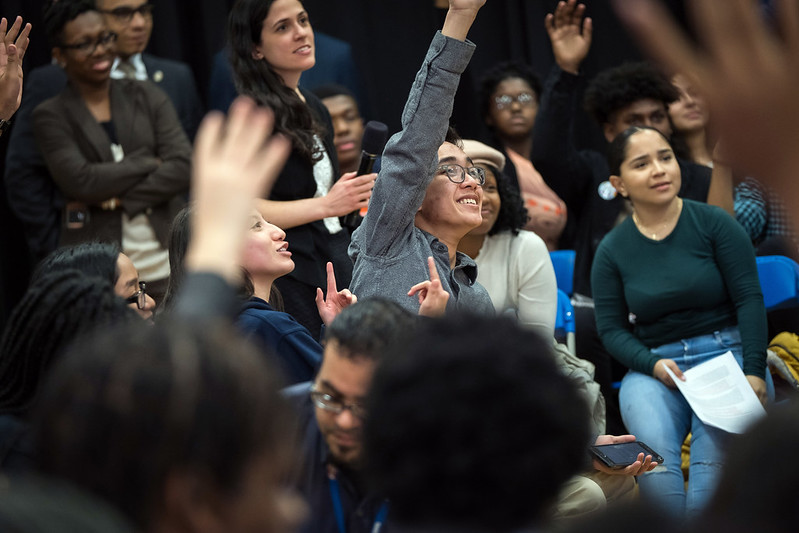
Students (photo: Ed Reed/Mayor's Office)
Like many states, New York’s sex education laws are dizzyingly complicated. Sex education itself is not mandated in New York public schools (though many school districts choose to teach it), but HIV/AIDs education is — though parents can opt their children out with the promise that they will teach the content at home. If sex education does take place, New York state law requires that it stresses abstinence, but makes no legal requirement concerning its medical accuracy. Some individual school districts, like New York City, do mandate a comprehensive sexuality education (CSE) curriculum, while others have no such requirement.
Democratic State Senator Samra Brouk’s bill (S2584) would simplify some of this tangled mess by making comprehensive sexuality education mandatory for all K-12 New York State public and charter school students, and it should be passed by both houses of the Legislature and signed by the Governor as soon as possible.
CSE is endorsed by the American Medical Association, the American College of Obstetricians and Gynecologists, the Society for Adolescent Health and Medicine, the American Public Health Association, and others. And with its dedication to being “age-appropriate, medically accurate, and inclusive of all students,” CSE should be the bare minimum of what we ask of sex education in schools, and Brouk’s bill should be a no-brainer.
But if history is any guide, there is no guarantee that our young people will be given what they are owed. New York’s 2020 legislative year saw six very similar bills to Bourk’s, all of which failed.
Despite widespread support from medical, public health, and education experts, opposition to CSE is fierce in New York and nationwide. The Catholic Church and other conservative Christian denominations came out against a bill nearly identical to Bourk’s in 2019, and will almost certainly line up to do so against this one, and right-wing media is already at work misrepresenting the project.
“Get ready for the latest woke wave in education,” The New York Post began in an article about the bill. The Christian Post proclaimed: “NY bill could force schools to teach sex ed to kindergarteners, gender identity to 2nd graders.”
Both of these stances misrepresent the project of CSE. First, the implication that comprehensive sex education is new is false. Sex education in some form, for students of all ages (including kindergarteners), has been in the United States since at least 1913, and “comprehensive sex education” is a term that has been in use since at least 1981, if not earlier.
And while the term “sex ed” as levied in these articles tends to bring to mind a condom and a banana, in reality, CSE encompasses a whole range of things that most of us don’t think of as falling squarely into the category.
SIECUS, a comprehensive sexuality education advocacy group founded in 1964, publishes guidelines for CSE that would probably be used to develop New York curricula if Brouk’s bill passes. SIECUS outlines six “key concepts” involved in CSE: human development, relationships, personal skills, sexual behavior, sexual health, and society and culture.
SIECUS’ recommendations for the youngest grades are relatively tame, and mostly have to do with families, friendship, body parts, and feelings. Most of its focus is on teaching children that their bodies belong to themselves, a measure that works to reduce instances of childhood sexual abuse.
The frank discussion about masturbation, sexually transmitted infections, and HIV/AIDS for the younger grades, and the information about contraception, abortion, and gender identity for older ones may make some squeamish — but truthful answers, words, and names are better than the alternative.
And the alternative to CSE rarely is no sex education at all. While some school districts may choose to forego the subject entirely, often schools choose instead to employ an abstinence-only-until-marriage (AOUM) curricula, which has now been rebranded as “sexual risk avoidance education” (SRAE).
AOUM/SRAE curricula are marked by their refusal to instruct about (and sometimes even discuss) contraception, and have traditionally and consistently been homophobic, racist, tinged with a Christian bias, and can be medically inaccurate — all of which CSE classes correct for.
The reprehensible biases and misinformation in these curricula are enough to call for their immediate disuse, but the data also suggests that AOUM/SRAE classes just don’t work in any measurable way. CSE has a number of goals, some more quantifiable than others. But one of the markers of a successful sex education curriculum should certainly be its efficacy in preventing pregnancy and sexually transmitted infections — and on that score, AOUM/SRAE are demonstrably less effective than CSE.
And preventing STIs and pregnancy should be a priority everywhere, including New York. As of 2018, New York had the 10th highest rate in the nation for both chlamydia and syphilis, and 54% of all STIs were diagnosed in people under the age of 26. And though New York does relatively well nationally in terms of teen pregnancy, the United States has one of the highest teen birth rates in the developed world.
These are high-stakes issues: real-world problems screaming for real-world, data-driven solutions. CSE is one of those solutions, and we shouldn’t let willful misinformation about it cloud our perceptions or actions any longer.
***
Margaret Grace Myers is a Brooklyn-based writer. On Twitter @margaretgmyers.
New York’s Rape Laws Must Be Updated To Protect LGBTQ Survivors
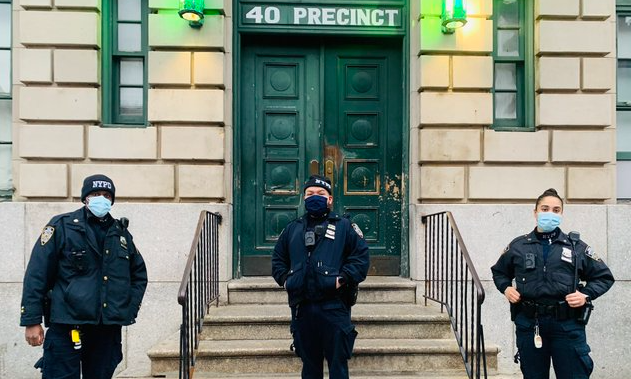
NYPD (photo: @NYPDnews)
In December, a group of models and influencers at Fashion Week publicly accused designer Alexander Wang of drugging and sexually assaulting them. The victims all painted the same picture: Wang would allegedly ply them with alcohol or lace a water bottle with MDMA, and then forcibly touch them, make them perform oral sex, or sodomize them while incapacitated. Many of the acts happened here in Manhattan at the popular bar Bedlam on Avenue C and at Wang’s West Chelsea apartment.
But the story has mostly flown under the radar. Why?
Because socially and legally, we downgrade sexual violence against men and transpeople.
Under the law, none of Wang’s alleged victims were technically “raped.” New York only recognizes this most serious crime as between a cis man and a cis woman. At most, the alleged attacks constitute criminal sexual acts. Rape is defined as only vaginal penetration and treats oral and anal sexual conduct as separate crimes. The rape statute is a relic of the Model Penal Code, drafted in 1962, seven years before the Stonewall riots and almost 50 years before many of the enumerated rights of the LGBTQ community. It relies on an outdated notion of sex suggesting queer people are deviant and transpeople do not even exist.
The social implications of 1962 live on. Reporting among men is incredibly low, less than 10% of reported rapes according to the National Sexual Violence Resource Center. When men do report they’re often met with skepticism. HBO’s I May Destroy You most recently dealt with this reality in an excruciating episode where a gay character tries to report being raped after first having consensual, anonymous sex with a man he met on Grindr. He’s doubly victimized by the police officer who shames him for not knowing his attacker’s name, and blames him for using a dating app.
Albany lawmakers can take an axe to the ingrained homophobia still baked into our laws by passing the "Rape is Rape" bill now. The legislation would remove the penetration requirement and define rape as either vaginal, anal, or oral “contact.”
Seems like a no-brainer, but the male dominated District Attorneys’ Association of New York State opposes it. When current Manhattan District Attorney Cy Vance headed up the association in 2013, he wrote a letter claiming the bill would “create an insurmountable hindrance to consecutive sentencing.” That’s just a technical pretext though, which is neither insurmountable nor a hindrance. The fact is the bill would allow prosecutors across New York to hold rapists accountable for rape no matter who the survivor is.
If politicians are willing to chant “love is love” then we should demand they declare rape is rape too.
***
Diana Florence is a Democratic candidate for Manhattan District Attorney. On Twitter @DianaJFlorence.
***
Have an op-ed idea or submission for Gotham Gazette? Email This email address is being protected from spambots. You need JavaScript enabled to view it.
This article has been corrected to accurately reflect classifications under the current law.
Is Cuomo Letting Scandals Get the Best of His Pandemic Judgement? What the Governor Must Do to End Covid in New York
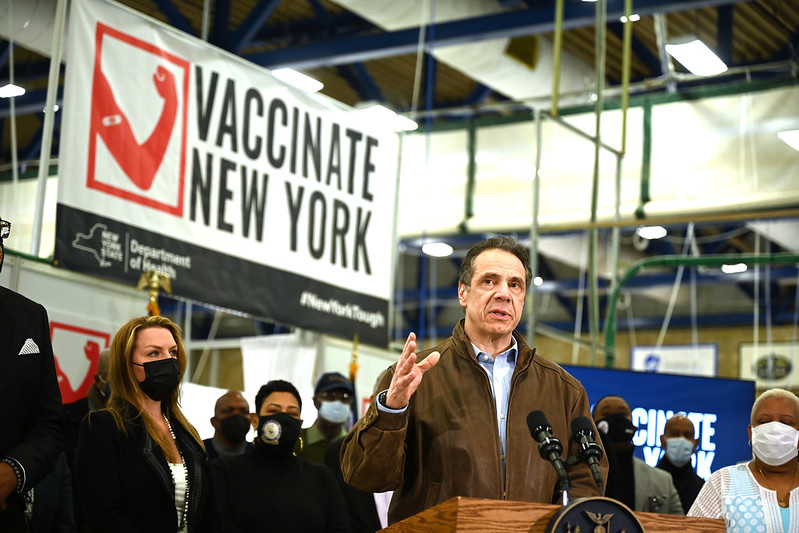
Gov. Cuomo (photo: Kevin P. Coughlin/Governor's Office)
Governor Cuomo seems to be letting his political scandals get the best of his judgement. Last Thursday, he announced sports stadiums and outdoor concerts can resume on a limited basis in April, even as New York State books more than 6,700 new cases each day. That is 6,000 more cases per day than we were registering at our lowest point last summer. Combined with his decision to increase indoor dining capacity, the governor’s move simply invites the virus and all its variants to infect more New Yorkers before the vaccine reaches enough people.
Despite all the talk of optimism, the situation remains serious and concerning. With new more-contagious variants spreading, the risk of another wave of infections exponentially rises each time we allow more people to gather. Even if people are vaccinated and tested at the door of stadiums and concerts, the virus can still spread, especially if new variants emerge that are less detectable or resistant to the vaccine. Our likely long-term endgame in that scenario – the one we need to avoid – is an endemic virus that mutates chased by vaccines that statistically reduce but do not eliminate the pandemic.
Governor Cuomo’s decisions, taken together with disastrous moves by Governors Desantis in Florida and Abbott in Texas, underscore why the United States always seems to be one step behind COVID-19 - cycling through a Groundhog Day-like pattern of opening, closing, and reopening again. Lawmakers impose restrictions when hospitalizations and infections rise. They lift those restrictions when metrics fall. Then - having allowed another crisis to mount - they’re forced to put those same restrictions back in place. This is unacceptable, and it doesn’t have to be this way.
By contrast, places like Australia, New Zealand, Vietnam, and Atlantic Canada have all returned to a sense of normalcy, mostly because they began taking aggressive steps before infections and hospitalizations got so far out of control.
Australia, for instance, has confined outbreaks by restricting inter-state travel among its eight states. In some cases, such as Melbourne in September and Sydney in December, travel restrictions were imposed within a city. This has at times been difficult for the 25 million Australians. But today, as the United States infection rate remains stubbornly high, Australia’s daily new case count is miniscule, averaging less than 11 new cases in the last week.
For the U.S. to change course for the better, we need to reset and choose to resemble Australia’s approach. That means doubling down on actions that stop community spread for a short period of time, providing space for vaccines to take hold and then re-opening in a targeted fashion.
The concept is simple: endure five weeks of stay-at-home orders now to save lives and put us in a position to reopen our economy as soon as possible. It means allowing only minimal essential services and mandating transmission prevention protocols like delivery, curbside pickup, mask wearing, air purification, and disinfection. It also means rigorous travel restrictions and 14-day traveler quarantines to prevent COVID-19 from crossing borders. The smaller the area, the faster the process of getting to zero. Testing, vaccinations, and mask-wearing remain critical, but they should not be the sole emphasis.
After one month of these measures, some areas will have eliminated community transmission. Those can be labeled green zones and begin reopening their economies. All other areas are labeled red. Travel between red and green zones should be limited. Week after week, more green zones will emerge, and travel can begin across a green zone travel network. Our model predicts that after six weeks, participating states could end community transmission of COVID-19.
I know there is a political desire to start making people feel good about gathering in large number s again. But neither politics nor wishful thinking should drive our pandemic decisions. It is this mentality that has dug us into a hell of our own creation. The only way we beat the virus is by using vaccinating and simultaneously imposing stay-at-home orders and travel restrictions to end transmission and stop variants from emerging. This is the fastest route back to normal. If New York does it, the rest of the world will follow.
***
Dr. Yaneer Bar-Yam is the founding president of the New England Complex Systems Institute, where he is an expert on pandemics and other complex systems. He is spearheading the effort of over 3,000 volunteers working to stop the outbreak at endcoronavirus.org. On Twitter at @yaneerbaryam.
***
Have an op-ed idea or submission for Gotham Gazette? Email This email address is being protected from spambots. You need JavaScript enabled to view it.
It’s Time to Do Away with SUNY’s Suffocating Fees
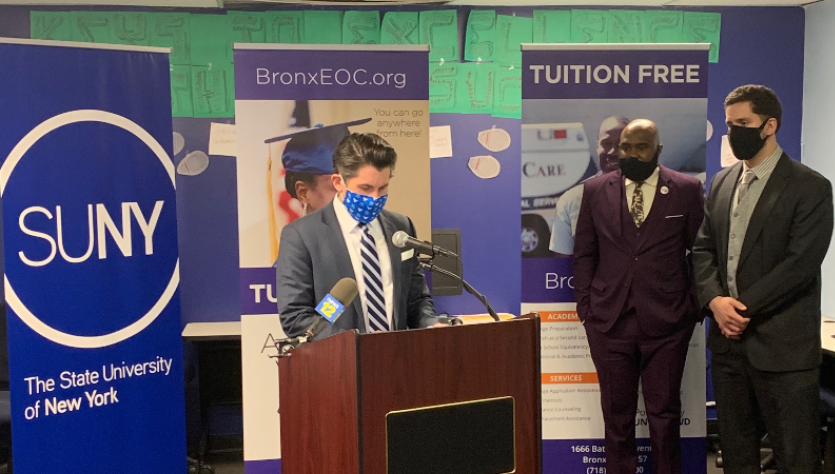
SUNY leaders (photo: @SUNY)
When I accepted my position to teach in the Anthropology department, I didn’t expect to be worrying about having enough to eat every day.
Yet that is the unfortunate reality many graduate student workers in the State University of New York (SUNY) system face, where the combination of exorbitant fees and a meager stipend for our labor push us to the brink of poverty.
At SUNY Binghamton, where I work as a Graduate Teaching Assistant, I shell out approximately $2,000 a year in fees, which is nearly 13% of my stipend.
These fees are purportedly for items like technology services and software programs that we need to use and access to do our jobs. There is no reason that we should be footing the bill for these expenses. Our employer is shifting the standard costs of the job to its employees. This has become even more outrageous during the COVID-19 pandemic, when we cannot even use many of the services we are being charged for.
We should not be asked to maintain operations at our schools when we have been hired to teach and provide high-quality instruction to students. It makes remaining in our programs nearly impossible, and takes away from our work. That is why I support a current State Senate budget proposal that would phase out mandatory school fees for graduate workers like me.
$2,000 might not seem a lot to some, but it essentially amounts to a 13% pay reduction. As a result, I have been forced to take out loans and live in an apartment without heat to save money for other essentials, like food. Many of my fellow grad workers rely on the food pantry on campus because we simply do not have enough cash to buy groceries.
All of this can take a significant mental toll on graduate student workers. We cannot focus on our work if we are struggling to meet our basic needs like paying for food and rent. We are here to teach and learn but instead our energy is often focused on simply surviving.
There is something fundamentally wrong with this dynamic. Graduate student workers should be treated with respect and dignity. And that means not paying to work. It’s time for the Legislature and the Governor to act and protect the integrity of our university system and the graduate workers who sacrifice so much for our state universities.
***
Ana Sanchez-Bachman is a PhD Graduate Worker at SUNY Binghamton.
***
Have an op-ed idea or submission for Gotham Gazette? Email This email address is being protected from spambots. You need JavaScript enabled to view it.
We Won the Fight for Better NYPD Transparency, Now Comes the Fight for Real Police Accountability
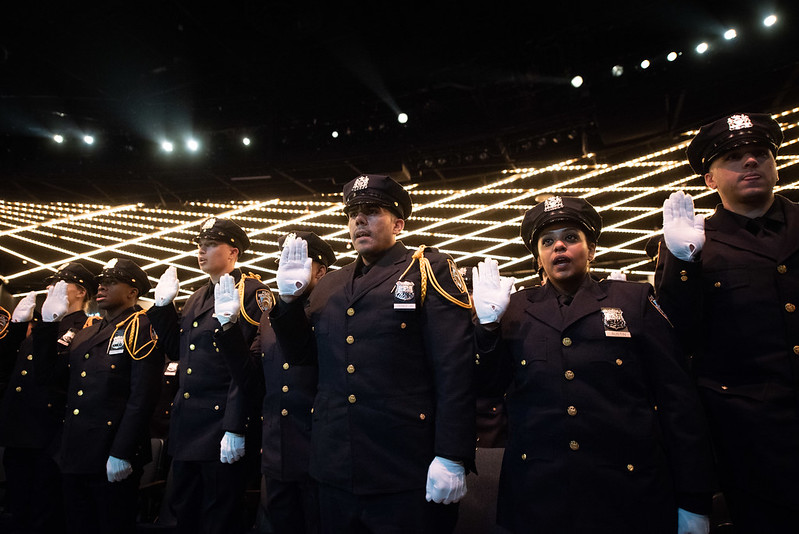
NYPD (photo: Michael Appleton/Mayor's Office)
Last summer, our state repealed 50-a, one of the worst police secrecy laws in the country, and required the NYPD to release previously hidden personnel records, that included officer misconduct and abuse cases. 50-a prevented parents like Gwen Carr, the mother of Eric Garner, from knowing whether the officers who killed her son by placing him in a banned chokehold and not coming to his aid as he pleaded to breathe had histories of misconduct. For years, it protected police from scrutiny at the expense of safety and transparency that New Yorkers deserve. I was proud to lead the fight alongside grassroots organizers for the repeal of that law, and earlier this month the NYPD made thousands of those records public.
We now have a clearer view of what “police accountability” in its current form looks like. In short, it’s a scary picture of officers facing few to no consequences for their documented misconduct and abuse. A closer look also demonstrates the need for District Attorneys who will hold police accountable for abuses.
Recent reporting on new data made public from 50-a’s repeal revealed that in more than 40 instances over the past five years, NYPD officers found guilty of abuse and misconduct by a police department judge had their verdicts voided by NYPD commissioners and faced no punishment. Despite the Civilian Complaint Review Board (CCRB) and NYPD judges evaluating evidence, hearing from witnesses, and finding these officers guilty of misconduct, they faced zero consequences because the police commissioner chose to reject those findings.
These stories are infuriating. We know that almost all Americans, over 95 percent, support accountability reforms that punish officer abuses. Over 95 percent of Americans agree that officers with multiple incidents of abuse of power should not be allowed to serve. But now that New Yorkers have the evidence, what’s next on actually holding law enforcement accountable?
The Manhattan District Attorney has not historically been an office that holds police accountable. Over the past decade, the District Attorney has prosecuted only a small handful of police officers who engaged in misconduct and broke the law. But the District Attorney’s office should be where officers face accountability -- the District Attorney’s is the most well-resourced office to handle cases of police excessive force and misconduct. The unfairness and injustice of a system that protects violent police officers is exactly why the next Manhattan District Attorney must be committed to fighting practices like this and holding police accountable.
This is not, and has never been, an easy fight. The NYPD has fiercely resisted change and reform for decades. Despite calls from every level of government, community organizations on the ground, and voters, the NYPD has defied efforts to increase accountability and transparency.
I know these fights -- I’ve gone up against the NYPD multiple times and won. In addition to repealing 50-a, I challenged the current Manhattan District Attorney, Cy Vance, when he wouldn’t release the names of officers that have filed false reports or lied under oath. Then-Public Advocate Letitia James and I also fought the NYPD and then-Commissioner Bratton to have officer body camera and dashboard camera footage released to the public, instead of classifying the footage as protected by 50-a.
The next Manhattan District Attorney will face enormous and immediate public pressure to enact real accountability measures when they take office. We have the evidence, and we know what steps to take, but who can the public trust to hold abusive police officers accountable for their misconduct? Manhattan needs a reformer, and for the past decade, I’ve led fights for reform from outside the District Attorney’s office and won. I’m the only candidate with a decade-long record of holding police accountable.
The history of police officers engaging in violent misconduct and not being held accountable has been a recurring problem in New York City. Past prosecutors-turned-District Attorneys have not held these officers accountable and brought about much-needed reform of our criminal legal system. As District Attorney, I will prosecute officers who use excessive force, lie under oath, and file false reports. I will release the names of officers who have proven to be untrustworthy, and I will always use my platform to advocate for comprehensive police reforms.
I’m running for District Attorney to make Manhattan safer for everyone. With the repeal of 50-a and the thousands of NYPD records released earlier this month, there will be more stories of officer misconduct and abuse disclosed to the public. And this June, Manhattanites have the opportunity to choose a proven reformer, someone who is best equipped to hold the NYPD accountable for these abuses. We can and we must build a New York that keeps everyone safe, and police accountability is a critical piece of achieving that safety.
***
Dan Quart represents parts of Manhattan's East Side in the New York State Assembly. He is a candidate for Manhattan District Attorney. On Twitter @AMDanQuart.
***
Have an op-ed idea or submission for Gotham Gazette? Email This email address is being protected from spambots. You need JavaScript enabled to view it.
State Democratic Party Launches Ethics Reform Committee
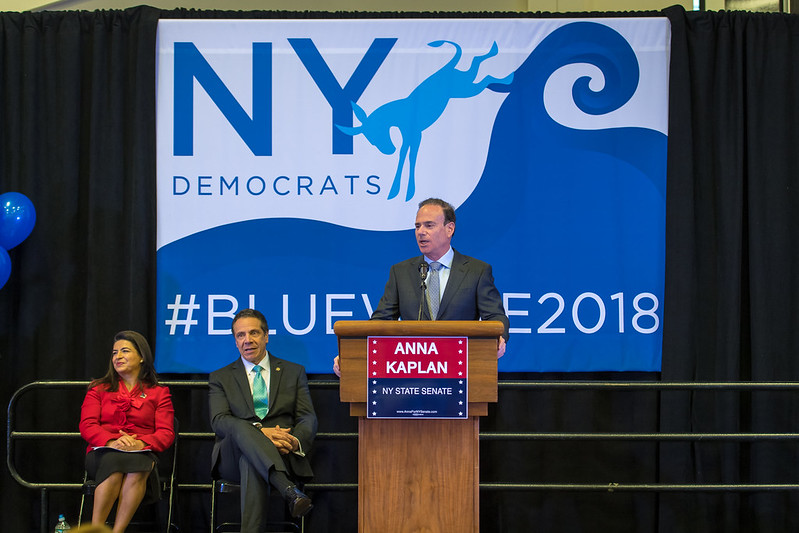
Jay Jacobs, Andrew Cuomo, Anna Kaplan (photo: Cuomo campaign)
The recent sexual harassment accusations against Governor Andrew Cuomo underscore the pervasiveness of a toxic work environment, especially for women. Lindsey Boylan, Charlotte Bennett, and Anna Ruch all came with receipts – contemporaneous emails, text messages, and photos – to corroborate their allegations against the governor. It took an immense amount of courage for them and other accusers to come forward. But simply applauding them for their courage does not do their bravery justice, nor does it change the environment that gives rise to these situations. We must act.
The #MeToo movement has succeded in centering a public discussion about sexual harassment and assault, especially their relation to power dynamics. Cuomo’s pattern of alleged behavior and overall scandal make it clear that more must be done to prevent sexual harassment and create a safe, independent space for people to come forward without fear of retaliation. We can start by creating that space in our own Democratic Party.
In 2019, several members of the New York State Democratic Committee and several County Committees reviewed the ethics process at both the State and County levels. What we found was a badly-flawed process that lacked the necessary independence required for such work. For example, in the current rules of the Democratic State Committee and Manhattan County Committee, the Chair directly nominates the panel that adjudicates ethics complaints and can remove any member for undefined reasons. Furthermore, the current ethics rules have no procedures for, or language about, sexual misconduct or discrimination and no ethics rules binding on all elected members of the State Committee.
With the help of sexual harassment experts, reform of New York Democratic Party ethics rules was proposed with five key objectives:
Creation of an ethics process independent of the Chair and other political actors.
Inclusion of specific language regarding sexual harassment, misconduct and discrimation.
The application of ethics rules to all State Committee and Executive Board members.
A centering on restorative justice and accountability in response to violations.
And, requiring an independent expert review of our ethics rules and policies, with a $10,000 budget.
These changes to the ethics rules were introduced in July 2020, but were not adopted. Instead, the State Committee tabled the discussion of ethics reform until the next meeting, which was held last October. At that meeting, the State Committee voted to establish a committee that would review the party’s ethics rules in depth, with the current proposal as a starting point. As of Monday, this Committee has been formed with a mandate to make our New York State Democratic Party a safer and more inclusive institution.
It is important to highlight that the proposed reform is not limited to sexual harassment, but gives all its members a way to report discrimination and/or ethic violations of any kind. It gives members of our party a way to have their grievances heard and adjudicated in a fair and impartial setting. It provides transparency and accountability and furthers our goals of making ours a more equitable party.
In the wake of the initial allegations against Governor Cuomo, New York State Democratic Party Chair Jay S. Jacobs released the following statement:
"I consider the Governor a friend. He has done and continues to do a lot of good for the people of our State. Nonetheless, these are serious allegations that require a fair, thorough and independent investigation. An independent investigation will best serve those making the allegations, the Governor and the people of the State of New York."
This is exactly why we need to establish independent investigations for sexual harassment and misconduct all egations. We cannot allow bad behavior to be swept under the rug, but without a safe, transparent process victims will fear retaliation and resolution will be dictated by political maneuvering. If a person can exercise their power to influence outcomes, no victim will feel safe enough to come forward. Perpetrators of harassment or assault - even powerful leaders - need to know that they can’t use their power to avoid justice.
Now is the moment for our New York Democratic Party to change so it can better reflect our ideals. In this Ethics Reform Committee, Chair Jacobs has the opportunity to back an open, transparent, and safe process within one of the key institutions for promoting people to power in New York State. We urge him to do just that.
***
Ben Yee is the Democratic State Committeeman for New York's 66th Assembly District and former Secretary of the Manhattan Democratic Party. Vittoria Fariello is a district leader from Lower Manhattan and a partner at Balestriere Fariello, a trials and investigations law firm that has prosecuted claims for sexual harassment, human trafficking, and other complex claims. On Twitter at @yben & @VittoriaNYC.
***
Have an op-ed idea or submission for Gotham Gazette? Email This email address is being protected from spambots. You need JavaScript enabled to view it.
Now’s the Time to Invest More, Not Less, in New Yorkers’ Mental Health
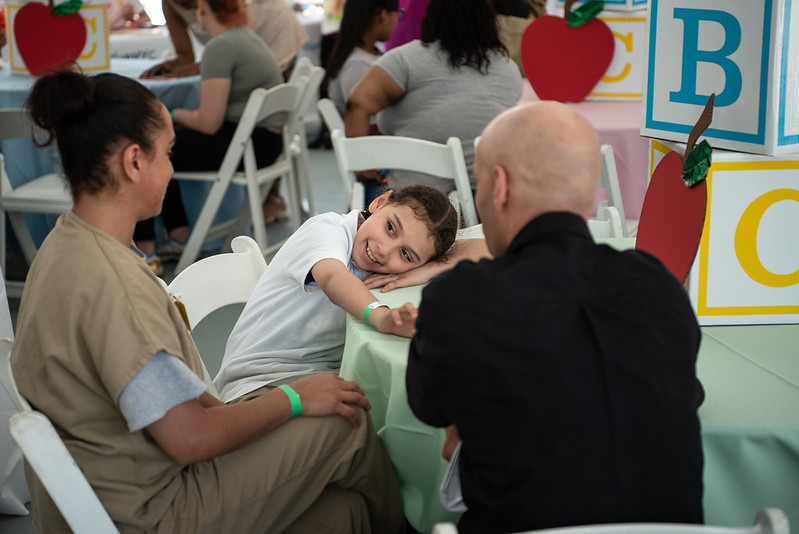
New Yorkers in need (photo: Michael Appleton/Mayor's Office)
Governor Andrew Cuomo has long-championed himself a progressive criminal justice reformer, committing his administration to “creating a fairer, safer, and more just system for all New Yorkers.” Yet his proposed 2021-2022 budget sharply contradicts this vision.
Not because he plans to continue closing state prisons as the incarcerated population drops. Though, we oppose his request for the ability to shutter correctional facilities with far less notice than the existing one-year requirement. When a closure looms, communities, inmates, and inmates’ families need ample time to make life-changing decisions.
Cuomo’s proposed budget is counterproductive because it would slash state-sponsored mental health and at-risk youth services, the very alternatives to incarceration needed to further reduce jail and prison populations. He wants to cut a whopping 446 positio ns at the Office of Mental Health due to attrition and nearly 300 inpatient beds for those with severe mental illness.
If anything, we should be investing more in these public services, especially during the pandemic and its aftermath. Rather than forcing the most vulnerable New Yorkers to shoulder the brunt of a sputtering economy, we should be leaning on those who can afford to pay more in taxes.
One of us is a parole officer and the other a licensed social worker. We’ve seen firsthand how our criminal justice system is deeply intertwined with our mental health system.
This is no exaggeration: Jails have become New York’s biggest mental health institutions. Rikers and other New York City jails have more patients with a mental health disorder than all the city’s hospitals. Statewide, some 15% of state prison and 26% of municipal jail inmates and detainees suffer from serious psychological distress, numbers far exceeding the non-incarcerated population (5%).
The proposed state cuts are the latest in a decades-long trend that has left people living with mental illness more likely to be arrested and incarcerated than receive the care they need. Between 2010 and 2016, New York’s public psychiatric beds were cut by 35%. Since 2010, staffing at the state’s Office of Mental Health (OMH) has been cut 17%, while staffing levels at the state’s Office for People with Developmental Disabilities has been slashed 15%.
The recent subway attack in New York City put human faces on these abstract statistics. Rigoberto Lopez, who allegedly stabbed and killed four people, was believed to be suffering from a mental illness when he was arrested multiple times in recent years. One of his victims in the stabbing had recently been hospitalized in a psychiatric ward.
One of the more worrying cuts is the proposed closure of Rockland Children’s Psychiatric Center in Orangeburg. This would force children and youth who require intensive, inpatient care for severe illnesses such as bipolar disorder to be relocated to the Bronx. It would also force families to travel further to stay involved in their child’s care.
Shifting to “brief, intensive, community-based care” sounds promising on paper. But the experiences of other states show that privatization of mental health care is a fool’s errand.
In 2015, then-Iowa Governor Terry Branstad drew fierce criticism for closing two state psychiatric hospitals, forcing elderly patients to move to private nursing homes. The criticism was warranted. Three longtime patients from one of the hospitals died shortly after being transferred.
When Utah considered privatizing forensic psychiatric care in 2010, its state legislature determined that cost savings may only result from reducing staff compensation, which could lead to high turnover rates and increased harm to patients.
In 2017, Alaska commissioned a study to find out whether privatizing a psychiatric facility would save money but concluded: “Our findings demonstrate that continued state management is not only the most advantageous route for generating overall cost savings, but that it also avoids many of the risks involved in contracting out the management of critical public infrastructure.”
Relying on our already-strained criminal justice system for mental health care isn’t working. We should invest in and expand services for our most vulnerable.
And we can afford it. Middle-class and low-income New Yorkers currently pay higher effective tax rates than billionaires and multi-millionaires. Let’s fix that and fund the important public services that keep our state safe, healthy, and thriving.
Governor Cuomo quoted himself at the top of his pandemic poster: “Wake up, America. Forget the politics, get smart.” Let’s wake up. Cutting and privatizing mental health care isn’t the smart thing to do.
***
Wayne Spence is a parole officer and Randi DiAntonio is a social worker. Spence is also the president of the Public Employees Federation (PEF), a union representing more than 50,000 New York State employees, including almost 6,000 at the Office of Mental Health. DiAntonio is a vice president of PEF, which is part of NYS Fund Our Future: A coalition of union, community and thought leaders building a thriving New York by making the case for government in the public interest. On Twitter @NYSPEF.
***
Have an op-ed idea or submission for Gotham Gazette? Email This email address is being protected from spambots. You need JavaScript enabled to view it.
New York Leadership Must Continue Supporting Pro-Immigration Policies While Washington Works on a Path to Citizenship
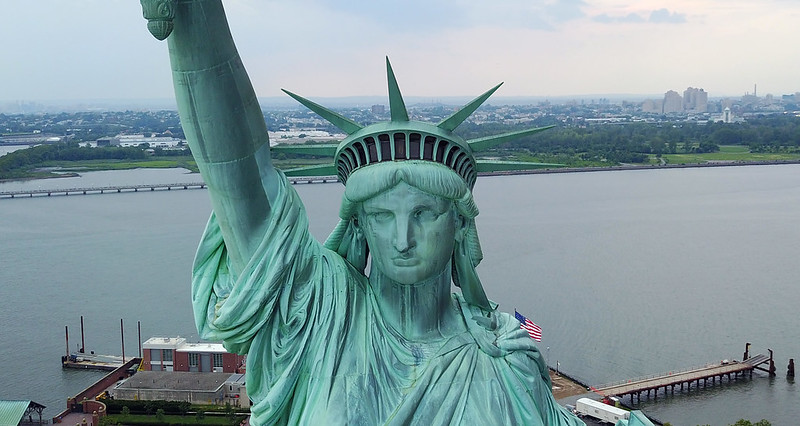
Statue of Liberty (photo: Kevin P. Coughlin/Governor's Office)
New York has long been recognized as a starting place for immigrants to discover new opportunities. However, we have strayed over the years from our nation’s values — especially as it relates to immigration policy.
Thankfully, members of New York’s congressional delegation — especially Reps. Nydia Velazquez and Yvette Clarke — are leading the charge to ensure a key group of undocumented immigrants have a pathway to citizenship. This is, however, just one step toward getting our broken federal immigration system back on track, which will take some time. In the short term, it is imperative that state elected officials and policy-makers continue to protect this vulnerable population.
Years of the Trump administration’s anti-immigration policies and rhetoric exacerbated immigrant communities’ many vulnerabilities, especially for undocumented immigrants who comprise about 15% of New York’s immigrant population. The coronavirus pandemic only made matters worse, resulting in a troubling increase in incidents in which vulnerable individuals required legal representation, from domestic abuse to housing evictions.
While some programs, policies, and initiatives were established to prevent the exploitation of New York immigrants, many undocumented individuals were continuously marginalized and often afraid to see k help due to fear of deportation.
New York’s state budget, due April 1, is on track to include $10 million to continue a critical program – the Liberty Defense Project, which provides free legal services to immigrants in need. This first-in-the nation initiative was created in 2017 as immigrants were facing four long and difficult years with Donald Trump’s arrival in the White House.
This program remains important as undocumented individuals have been largely excluded from state and federal aid packages throughout the pandemic, resulting in a host of legal challenges – from eviction and deportation to bankruptcy and domestic incidents.
But the Liberty Defense Project and similar efforts are merely a temporary fix. We need a permanent solution in the form of a pathway to citizenship for the millions of immigrants who serve our communities and keep our economy running.
The nation has begun to turn the page on immigration reform. Recent passage by the House of Representatives of two bills that would establish paths to citizenship or legal status for millions of undocumented immigrant — including the Dreamers, those brought to the country unlawfully as children, as well as farm workers – indicates progress.
One of these bills, the American Dream and Promise Act, would help about 28,180 young immigrants across the nation currently protected under the Deferred Action for Childhood Arrivals (DACA) program. That includes 9,200 workers deemed essential during the pandemic, including health-care providers, teachers, sanitation and food industry workers.
These same essential workers would receive additional on-the-job protections through the state-level NY HERO Act. This legislation, which recently passed the state Senate, requires employers to establish health and safety standards for COVID-19 and other airborne infectious diseases in the workplace.
This is one example of a concrete step state lawmakers can take to protect vulnerable New Yorkers – including immigrants – while we await further action in Washington. The Assembly should quickly follow the Senate’s lead and pass the NY HERO Act without delay.
It is imperative that members of the U.S. Senate, especially Majority Leader Chuck Schumer, New York’s senior senator, finish what the House has started and approve the American Dream and Promise Act and the Farm Workforce Modernization Act. While these initiatives make their way through the legislative process in Washington, New York must continue to live up to its reputation as a progressive leader by protecting the more than 4.3 million immigrants who call the state home.
Until a federal path to citizenship becomes a reality, state lawmakers must continue working to protect undocumented immigrants while also benefitting all New Yorkers. The hardworking men and women who have kept us safe throughout the pandemic and contributed for years to our economy deserve nothing less and cannot wait any longer for action.
***
Camille Mackler is executive director of Immigrant ARC, a nonprofit organization that mobilizes New York’s network of legal service providers by facilitating communication and information sharing to better support immigrant communities. On Twitter @cmackler and @immigrantarc.
***
Have an op-ed idea or submission for Gotham Gazette? Email This email address is being protected from spambots. You need JavaScript enabled to view it.
The State Can’t Again Take Federal Funding Meant for New York City Schools
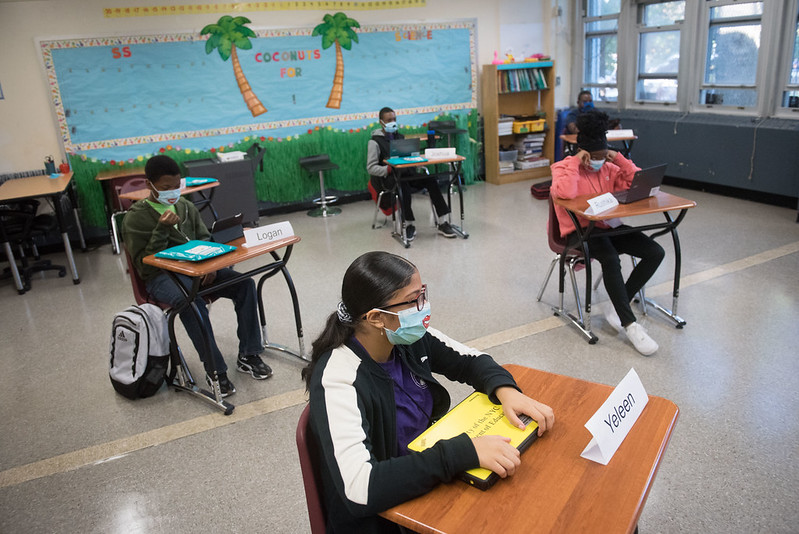
Students in school (photo: Michael Appleton/Mayoral Photography Office)
Here's the deal: This time last year, the New York City Department of Education closed schools for in-person learning because of the early devastation COVID-19 was causing in New York. While we all understood this was necessary, what happened next was a completely inappropriate and very unnecessary response to that closure by the State.
The New York City public school system closed for in-person learning during the home stretch of negotiations over
the 2020-2021 New York state budget. These negotiations are normally a hectic time for legislators, the Governor, and communities alike. But with a closed New York City school system, hundreds of schools and over a million students and families were anxious to know what education was going to look like for the foreseeable future. The State Legislature and Governor Cuomo were also desperately trying to figure out how to fund the shift to remote learning.
In that context, the federal government stepped in with the CARES Act to lessen the burden by allocating emergency funding for states to transition to remote learning. That relief, however, came with a caveat: new funding was supposed to be used to supplement education. It was supposed to be used "in addition to" and not "instead of." The result? Something called a "pandemic adjustment" that supplanted normal education funding with CARES Act funding — essentially, the state took education funding intended for the city.
This pandemic adjustment coupled with the "20% withholding" stunt the governor pulled right before schools reopened resulted in very real resource challenges at the Department of Education. The "furloughs” that followed for managerial and nonunion Department of Education employees caused financial hardships on some district staff like Education Council Administrative Assistants that had to go unpaid for a week at a time when none of us could afford to.
As the State Legislature and Governor Cuomo consider the 2021-2022 state budget, which is due by April 1, and funding priorities for a new round of federal relief are on the horizon, we must not repeat recent history. We must not repeat adjusting the budget on the backs of our children and families. The final New York state budget must not take hundreds of millions of dollars in federal education aid meant for New York City.
Instead, we must have access to the full state and federal education funding in order to build on the long-term investment made to bridge the digital divide with 500,000 iPads and provide additional access to technology and broadband for low-income students and families to support them in remote learning environments, not to mention the fact that every child and family needs such access even when students are in school five days a week.
We must expand funding for language access for English language learners who have had difficulty receiving comprehensive technical support in their native languages. We must provide additional funding for students with disabilities who have been unable to receive continuous in-person access to the therapy and related services they need. We must provide additional funding to help Black and brown communities across this city who have disproportionately suffered extraordinary trauma and loss due COVID-19. We must provide additional resources to support education for incarcerated minors who have languished in jails during this pandemic. We must also provide additional resources for all our parents to support our children's education, especially but not only due to our new roles as remote educators.
In addition to an investment in people, we must also make a massive investment in our education infrastructure. We must invest in the wholesale repair, upgrade, and modernization of our aging school buildings. We must invest in new school buildings that can safely accommodate students with disabilities. We must provide our children return to spacious classrooms, modern facilities, clean drinking water, and contaminant-free air. And we must invest in infrastructure that ensures that we never disconnect any child from the education to which they have a right.
Our children and families need additional resources, especially as this pandemic's long-term impact on our system becomes more evident. As we consider the different supports that our students, families, and school communities need, we must do so with an understanding that this is a long-term process. Given the recently-offered one-house budgets released by the State Assembly and Senate, we see that the New York State Legislature is with us in our fight, but it must be made clear: it is time for the Governor to do his part. He must not supplant federal funding at the expense of our students’ and families' futures. No more schemes or "pandemic adjustments." The new state budget must fully fund our schools and provide the additional resources necessary so our children may have access to a high-quality education.
***
Thomas C. Sheppard is the Community Education Council Presidents’ Appointee on the New York City Panel for Educational Policy (PEP). On Twitter @TomCSheppard.
***
Have an op-ed idea or submission for Gotham Gazette? Email This email address is being protected from spambots. You need JavaScript enabled to view it.